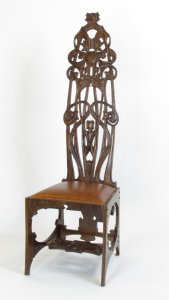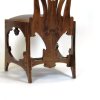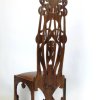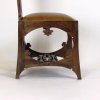- Seating
- Peter Marcucci
Peter Marcucci
Member Gallery
Address
Contact
Charles Rohlfs Tall Back Chair
Rohlfs furniture contains many of the elements of arts and crafts furniture, but is set apart by its unique design and shapes, artistic ornamentation, fretwork and carving details which have Art Nouveau, Asian and Gothic influences. Writers have described Rohlfs’ furniture as artistic, complex, idiosyncratic, eclectic and eccentric.
There are two books which I have referenced through this time. Drama In Design, The Life and Craft of Charles Rohlfs, Michael L. Lames, Birchfield Art Center, Buffalo New York, 1994 and The Artistic Furniture of Charles Rohlfs, Joseph Cunningham, Yale University Press, 2008.
These books provide extensive biographical information; contain hundreds of high resolution photographs of his furniture along with descriptions and analysis of his works. The analysis while interesting to me is written from an art history or decorative arts scholarly perspective.
My focus is to understand Rohlfs from a woodworker’s perspective, to build some of his furniture and un-lock and document the details of its construction. Woodworking magazines include in their archives, numerous projects from arts and crafts era builders like Morris, Stickley and Greene. While people can view Rohlfs furniture from a distance in museums, I believe the best way to preserve his work is to show people how it was built and hopefully encourage them to build it themselves.
I can’t hope to make exact reproductions of his work, but rather my goal is to make a “faithful” reproduction. In a few cases, such as Rohlfs’ Coal Hod, (which is a large lidded bowl shaped container used to store coal in the parlour next to the stove) I have modernized the design into a coffee table.
I routinely search the internet for pictures of Rohlfs work. Auction websites sometimes include very useful photographs of Rohlfs furniture, providing basic information about the size, colour and ornamentation. In most cases they include front, side, rear and three quarter views.
If it is possible a road trip to a museum to see the work first hand is helpful. On a number of occasions I have emailed museum curators with a few questions about a piece. I have been pleasantly surprised at their willingness to respond and provide the information I asked for.
I built Rohlfs Tall Back Chair in 2012. To my eye it is one of the most beautiful chairs that I have ever seen.
Before going further, I want to thank Dr. Karl Kusserow, Curator of American Art at thePrinceton University Art Museum for the information and pictures he provided me on Rohlfs Tall Back chair. I wanted to confirm some of the dimensions and get a few pictures of some of the carving. I was hoping that he would take a few pictures with his phone and send them to me. Instead he removed the chair from display and had it professionally photographed. That was so gracious. Wow.
This information was useful in developing the plans for this chair. I also had an opportunity to visit the Princeton University Art Museum on a trip to New York city and see Rohlfs tall back chair first hand. I spent about an hour looking at the chair, taking photos and videos of it from as many angles as possible.
As with Rohlfs desk chair, I was surprised at how light the chair structure is and how fine the carving is. The thickness of the wood is less than ¾ inch. The carving is quite intricate and delicate looking.
I had a 2”×8”× 60” piece of walnut left over from a Malolof rocker build and various other small pieces of walnut. I resawed the 2 inch thick piece into two boards which I book matched to form the back. The grain pattern of the book matched walnut matches the shape of the back quite nicely.
I spent a considerable amount of time piecing together the other small walnut pieces I had left over make up the boards needed for the other parts of the chair. Each side is made from four pieces, which in turn were each glued up from smaller walnut boards.
Structurally, the chair is actually quite simple, only five parts and some braces. The main feature and challenge is the carved back. I'm still learning to carve so this was my biggest challenge. It took several days for me to carve the back.
A friend, a professional upholsterer, upholstered leather seat.
This is the 8th of an eventual 25 Rohlfs’ pieces that I hope to research and recreate.





